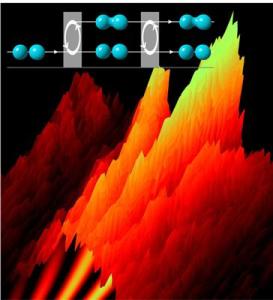Nov 24 2010
Everybody is familiar with the problem to choose between two alternatives. This also holds for relationships.
The question whether being a couple or not has a yes-or-no answer – either one is a couple or not. Quantum physics offers an interesting alternative. There, the couples are pairs of atoms that are held together by binding forces to form molecules. Quantum mechanics allows another loophole: a superpostion of free and bound state, where the two atoms are bound and free at the same time. Although this is impossible in our classical world, it is a well known property for quantum mechanical states. Such superpositions have now been observed at the „Universität Stuttgart“ (University of Stuttgart) for weakly bound ultralong-range molecules. Physicist Tilman Pfau and his group showed, that these superposition states last for several millionth of a second - too short for a real relationship, but long enough for molecules, as Björn Butscher and his colleagues report in the online version of Nature Phyiscs.
 Image: Interferometer for Rydberg-molecules: A laser pulse (grau) excites pairs of Rubidium Atoms into a superposition state between free atoms and bound molecules. With a second pulse, the different temporal evolution of these two states can be mapped back to the number of detected molecules.
Image: Interferometer for Rydberg-molecules: A laser pulse (grau) excites pairs of Rubidium Atoms into a superposition state between free atoms and bound molecules. With a second pulse, the different temporal evolution of these two states can be mapped back to the number of detected molecules.
Only recently, the Stuttgart physicists provided experimental proof for the existence of the so-called ultralong-range Rydberg molecules. These are weakly bound molecules where one atom is in its ground-state while the other atom is in a highly excited state – a Rydberg state. With bond lengths of 100 nanometers, these molecules are extraordinarilly large. In their new experiment, the scientists now demonstrate the control of these superposition states.
To form the exotic molecule, two ground state atoms need to be at the right distance. Since atoms at room temperature are moving too fast to form a molecule, the physicists cool a gas of Rubidium atoms to a temperature close to the absolute zero temperature and illuminate it with laser pulses. This lifts the outer electron of one atom to a high orbit and Rydberg-molecules can be formed. In their new experiment the physicists could show that they can coherently control the transition from the unbound state of two free atoms to the molecular state. This means that the atom-pair is bound to the light so much that it oscillates periodically between the bound and the unbound state and take all intermediate superpositions while the light is on.
Depending on the length of the laser pulse, they can create a bound pair or an unbound pair or a pair that is simultaneously in both, the bound and in the unbound state – the superposition state. If the pair is in such a superposition, it is extremely sensitive to external effects that diffently affect the bound and the unbound state. Using two separated laser pulses, the physicists could realize an interferometer for bound states that they employed to measure the lifetime of the molecules.
This work has been funded by the Deutschen Forschungsgemeinschaft DFG, SFB/TRR 21 (Control of quantum correlations in tailored matter) and the Carl-Zeiss-Stiftung unterstützt.
Source: http://www.uni-stuttgart.de/